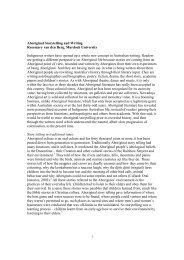Polona Petek - [API] Network
Polona Petek - [API] Network
Polona Petek - [API] Network
You also want an ePaper? Increase the reach of your titles
YUMPU automatically turns print PDFs into web optimized ePapers that Google loves.
Voicing Dissent(1912–1913), and were finally elaborated in the paper entitled ‘On narcissism: anintroduction’ (1914). 7 Here, Freud observes different manifestations of narcissism;that is, as a form of perversion, as an attitude in other mental disorders, and as astage in ‘normal’ human sexual development. The latter is understood as anecessary intermediate stage between auto-eroticism and object-love, and it ismore precisely described as primary narcissism. According to Freud, complete(heterosexual) object-love only happens in males whereas in females he observesan intensification of narcissism, for object-love requires repression of primarynarcissism and the most significant part of repression is castration anxiety. 8 Onceprimary narcissism has been repressed, secondary narcissism may arise. The lattermight yield itself to melancholia, in which, to alleviate the loss, a lost love-objectis re-constructed inside the ego, and the frustrated and therefore withdrawn sexuallibido is transformed (back) into narcissistic libido. Since primary narcissism ismerely repressed and never abolished, it also reappears through the subject’ssetting-up of the ego ideal, which is essentially the substitute for the lostnarcissism, and through the emergence of the super-ego, whose task is to ensurenarcissistic satisfaction by means of demanding the ego’s fulfilment of this ideal.If ‘normal’ human sexual development goes awry, at least temporarily, therepressed narcissism returns. This is the idea, which buttresses Otto Rank’s 1914theory of the double 9 as one of the possible manifestations of the return of therepressed narcissism in art and which finds an even more powerful elaboration inFreud’s influential essay ‘The Uncanny’ (1919). 10 In Rank’s and Freud’s view, thedouble represents a personification of a pathological self-love and, at the sametime, an embodiment of the fear of one’s self. It is an uncanny manifestation ofunrestrained narcissism and a symptom of paranoia. In Freud’s later terms, thedouble emerges as the externalised, projected ego-ideal, stemming from therepressed narcissistic ‘omnipotence of thoughts’, that is, from one’s overvaluationof one’s own mental processes, and thus assuming a potentially friendly aspect;yet also as the split-off, detached and downright hostile superego, from whichlibido has been withdrawn due to its too severe demands imposed on the ego. 11What becomes evident in this summary is Rank’s and Freud’s assessment of theinherently ambiguous, indeed ambivalent and uncanny nature of the double.Karmel’s film employs the double in its most straightforward form: itsprotagonist Pamela Drury (Rachel Griffiths) encounters a fully materialisedversion of her mirror image in the middle of the day and literally in the middle ofthe street. That some sort of a disturbance in relation to one’s self — that is, neitherthe ‘normal’ feminine intensification nor the usual masculine repression ofnarcissism — is involved is signalled right from the opening titles of the film. Thevery first shot shows a running cassette recorder and the audience hears voices ofadolescent girls, accompanied with close-ups of their faces shortly thereafter,discussing their plans and dreams for the future. In the following scenes, theviewers realise that the tape belongs to a journalist, Pamela, and we are offerednumerous hints that she is writing the article on teenage girls as some sort ofcompensation for the utter dissatisfaction with her single life: she is completelyconvinced that she has ‘missed the train’. Pamela’s narcissistic unease emergesfully in the next scene, which takes place in front of the bathroom mirror, in whichPamela is reading the tags with her self-esteem-raising mantras. While the camera160


![Polona Petek - [API] Network](https://img.yumpu.com/40542952/2/500x640/polona-petek-api-network.jpg)
![Dream and Nightmare in William Gibson's ... - [API] Network](https://img.yumpu.com/49298598/1/184x260/dream-and-nightmare-in-william-gibsons-api-network.jpg?quality=85)

!['Fuck All Editors': The Ern Malley Affair and Gwen ... - [API] Network](https://img.yumpu.com/42446228/1/184x260/fuck-all-editors-the-ern-malley-affair-and-gwen-api-network.jpg?quality=85)
![to download as a PDF. - [API] Network](https://img.yumpu.com/35170825/1/184x260/to-download-as-a-pdf-api-network.jpg?quality=85)
![Edward Koiki Mabo: The Journey to Native Title - [API] Network](https://img.yumpu.com/33197148/1/184x260/edward-koiki-mabo-the-journey-to-native-title-api-network.jpg?quality=85)
![Gallipoli, Kokoda and the Making of National Identity - [API] Network](https://img.yumpu.com/31766380/1/184x260/gallipoli-kokoda-and-the-making-of-national-identity-api-network.jpg?quality=85)
![Indigenous Knowledge and Pharmaceuticals - [API] Network](https://img.yumpu.com/24108846/1/184x260/indigenous-knowledge-and-pharmaceuticals-api-network.jpg?quality=85)
![Ferals: Terra-ism and Radical Ecologism in Australia - [API] Network](https://img.yumpu.com/13809010/1/184x260/ferals-terra-ism-and-radical-ecologism-in-australia-api-network.jpg?quality=85)
![Big Chief Little Wolf: Wrestling, Radio and Folklore in ... - [API] Network](https://img.yumpu.com/12204748/1/184x260/big-chief-little-wolf-wrestling-radio-and-folklore-in-api-network.jpg?quality=85)
![Dark Tourism and the Celebrity Prisoner - [API] Network](https://img.yumpu.com/4348795/1/184x260/dark-tourism-and-the-celebrity-prisoner-api-network.jpg?quality=85)